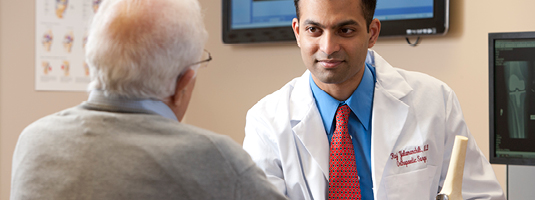Joint Replacement Therapy

The University of Maryland Rehabilitation Network provides treatments for knee, shoulder, hip and other joint replacements. We offer complete pre- and post-surgery care for patients who need joint replacement, including physical therapy, occupational therapy, educational sessions and support programs. Our therapy programs are designed to relieve your pain, increase your range of motion, and get you back to your everyday activities as quickly as possible.
The "Right" Physical Therapy with Joint Replacement Surgery
Not all physical therapy programs are the same, and finding the program that is right for you is important for successful joint replacement. At the UM Rehabilitation Network, we are committed to providing you with an excellent care experience and the best possible outcomes. To accomplish this, we follow best practice guidelines to create a custom program for each patient based on their abilities, condition and personal goals. Patients are paired with a team of experts from different disciplines who are specially-trained in total joint replacement therapy. Offering the expertise of many board certified specialists and low therapist-to-patient ratios, the UM Rehab Network provides the best, most individualized care possible. And because our specialists are extremely collaborative across the Network, our patients benefit from knowledge, technology and facilities throughout Maryland.
Joint Replacement Recovery & Rehabilitation – What to Expect
The UM Rehab Network offers all levels of joint replacement rehabilitation, and we work with our patients through each phase of their treatment to achieve the best outcomes.
Our approach is simple: We ask our patients what they want to be able to do after joint replacement. Whether their goal is to return to playing sports, go back to work, or keep up with their young grandchildren, our team of specialists creates an individualized therapy program that will get them back to that activity.
Benefits of Therapy Before Total Joint Replacement
Many people who need a joint replacement have had long-term pain and mobility issues and have become deconditioned as a result. Patients who get targeted therapy prior to surgery may have an easier and faster recovery. Using accessible equipment that's easy for them to use, we work on improving their muscle strength and joint range of motion, as well as getting their heart rate up to build cardiovascular endurance so that they can go into surgery in the best shape possible. Depending on a patient's condition, they may undergo presurgery therapy for two weeks or more.
Recovery Following Total Joint Replacement: Knee, Hip or Shoulder
Promoting motion and mobility soon after surgery has proven to be extremely effective after a joint replacement, so we generally begin working with a patient on increasing range of motion, strength and getting up and moving either the same day or the day after surgery.
Before and after surgery, physical and occupational therapists work with your physician and entire care team to effectively manage your pain using of a variety of tactics. This can include hands-on therapy, like targeted massage or soft tissue work to allow the muscles and joints to move more freely, and other modalities, as needed, like electrical stimulation.
Following surgery, the therapy team assesses all muscle groups to determine areas of weakness, and they create a customized exercise program to address those areas. Your therapist will work with you on any number of exercises in a therapy gym or in a heated therapy pool. Aquatic therapy, which is offered at many locations throughout the UM Rehab Network, is great for joint replacement patients once they are cleared by their doctor, because the heated water allows them to move more freely and get a good workout with no impact on the joint.
Most physical therapy programs following a total joint replacement take 2-4 months, but the frequency and total length of the program varies from patient to patient. By the end of recovery, patients should experience the following:
- Pain relief by two weeks after surgery
- Improved mobility by two weeks after surgery
- Increased level of activity by four weeks after surgery
- Improved flexibility approximately four weeks after surgery
- Feeling stronger and more confident overall approximately 8 weeks after surgery
- Return to leisure activities approximately 12 weeks after surgery
